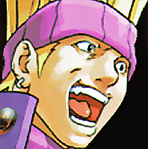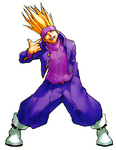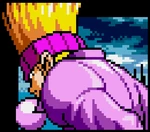No edit summary Tags: Visual edit apiedit |
No edit summary Tags: Visual edit apiedit |
||
| Line 11: | Line 11: | ||
|likes = Army knives, fighting video games |
|likes = Army knives, fighting video games |
||
|dislikes = His true name, effort, ghosts |
|dislikes = His true name, effort, ghosts |
||
| − | |measurements = |
+ | |measurements = 88 cm (34"), 59 cm (23"), 72 cm (28") |
|fightingstyle = Dirty gangster tactics |
|fightingstyle = Dirty gangster tactics |
||
}} |
}} |
||
Revision as of 11:39, 18 September 2017
Edge (エッジ), also known by his real name Eiji Yamada (山田 栄二 Yamada Eiji), is a fighting game character from the Rival Schools games.
Biography
Edge, the "Bloody Knife"
Edge is a student from Gedo High School and member of the school's gang, introduced in Rival Schools: United By Fate. His most distinguishing features are his blonde hair (usually styled into comically tall spikes), his default purple outfit and his use of Army knives when fighting.
Irresponsible and unfair. These are two words that best describe Edge. No matter who his opponent is, he always has some Army knives ready with him, earning him the moniker "Army Knife's Edge". He is somewhat vain--if he sees his clothes get wrinkled a little, he grabs the chest area or collar and fixes the crease. Never dare call him by his real name, or he'll get angry (and probably go on a rampage).
Appearance
Edge has long blonde hair, which is spiked upwards, with comical tall spikes. He wears a pink headband. His primary outfit is a purple school short jacket under a pink high-neck sweater, purple school pants and white boots. The interior of his jacket is white and has a knife holsters inside of his jacket where he keeps his army knives.
Story
Rival Schools: United By Fate
In Rival Schools, Edge and Gan are two of the Gedo students who joins a disguised Akira in finding the whereabouts of Gedo's gang leader, Daigo. Though Edge is initially suspecting of Akira, and even engages in a fight with her to test if she is really their boss' younger brother, he eventually comes to accept her, especially after she reveals her true gender. His ending has him initially choosing to stop picking fights with other children, but changes his mind at the urging of several of his classmates.
Project Justice
In Project Justice, Edge (who surprisingly made it to the second year of high school) becomes suspicious when a returning Daigo has him and Gan performing various, irrational attacks against other schools. Edge is the only person who discovers Daigo has been ordered by Momo Karuizawa to deal with the students in Gorin High. When Daigo silently leaves to "take care of" the Gorin students, Edge begins to suspect their boss' actions. When both Gedo High and Seijyun High begin to have a school gang war, Edge and Gan realize that Daigo is not the person they knew and something had happened to him from his training trip. They eventually realize that Daigo was brainwashed by Kurow. Edge and Gan quickly comes to Akira's aid as she tries to wake her older brother from the brainwash, but to no avail, she is forced to fight him with their assistance. Zaki hears whistle noises and realizes that Yurika is playing Kurow's flute in hiding. As Daigo is freed from brainwashing, he reunites with his younger sister and stating that their strength of their punches had freed him from being the mind control. Edge and Gan became infuriated to see that Justice High School was behind everything as Daigo tells them that the truth will reveal beneath Justice High.
After Kurow reveals his disguise, he attempts to brainwash Daigo once again by playing his flute, Edge attempts to attack Kurow only to be blocked by Momo. Luckily, Zaki manages to get Kurow's flute with her chains and Daigo returns to normal.
After the incident, Edge and Gan became the new undisputed gang leaders after Daigo gives his leadership to them and leaves to train once more.
Gameplay
Arsenal, combat style and fighting strategy
Special Moves
- Backstab (Japanese: 裏斬り Uragiri) - Edge does a knife throw. Depending on the punch button being pressed, Edge may end up with his back turned towards the opponent, or remain facing the opponent. Either way, he can still do another knife throw. Edge is more vulnerable to counterattack when his back is facing the opponent. This can be done up to four times.
It can also be done in the air, where Edge may simply throw a knife 45 degrees downward, or may do it after a forward flip. Unlike the ground version, this cannot be done four times. The first aerial version, however, can be followed by another Air Combo if the player is fast enough. It is of note, however, that the aerial version cannot be done four times in succession as in the ground version.
This move also has an anti-air version, the Anti-air Backstab (Japanese: 対空裏斬り Taikuu Uragiri). In this version, Edge throws his knife 45 degrees into the air. This is a ground-only attack, and can also be done up to four times in succession as the normal Backstab.
- Abuse (Japanese: 罵倒 Batou) - Edge kicks some dirt into the opponent's face, blinding the latter momentarily. Depending on the kick button pressed for this move's button combination, he may either do this move with a simple snap kick, or turn his back on the opponent before doing a forward flip that does the same thing as the first version.
- Destruction (Japanese: 破壊 Hakai) - Edge sidesteps and does a dive towards the opponent. Depending on the kick button pressed for this move's button combination, the attack may either aim at approximately knee-level, or for the midsection.
This is also usable in the air, also with two versions. The attack may be delivered at a steep angle, or at a 45-degree angle.
Burning Vigor Attacks
- Grand Backstab (Japanese: 壮絶な裏斬り Souzetsu na Uragiri) - Edge throws numerous knives at once towards the opponent. Deals only one hit, but the damage is massive. If the opponent blocks this attack, he/she has to block all the knives; otherwise, this will still cause damage, albeit lesser. Also usable in the air.
- Bloodbath (Japanese: 血祭り Chimatsuri) - Edge does a sidestep, then dashes forward and executes quick knife throws and ends with a knockdown kick. It can be activated for up to approximately four steps away from the opponent. Highly recommended for a Tardy Counter due to its almost instantaneous startup.
Team-Up Technique
- Bloody Prison (Japanese: 血゛獄 Jigoku) - The active character starts with a jumping spin-kick, pushing the opponent a few paces away. Edge and the active character then do three dashing slashes, circling the opponent.
Party-Up Technique
- Edge does the Gedo Top.
Cameo Appearance
Edge makes a cameo appearance in Capcom vs. SNK in the Kyokugen Dojo stage and he appeared as a card in SNK vs. Capcom: Card Fighters Clash. Edge also had a small cameo appearance in UDON's Street Fighter Legends: Sakura comic.
Trivia
- The following details on Edge's life is as described.
- Being a delinquent, he obviously fares poorly in any subject taught in school.
- He has tried several part-time jobs before (e.g. coffee shops, video stores), but he never lasted that long in any of those jobs, leaving him jobless prior to the start of United by Fate.
- He is the youngest of three siblings. Both his brother and sister are of upstanding socialities, and so are his parents, making him the family's "black sheep".
- Design-wise, Edge looks like a combination of Benimaru Nikaido and Ryuji Yamazaki from SNK Playmore's The King of Fighters series of fighting games.
- He is the only character to have an official alias in United by Fate. This is because another character introduced in Project Justice also has an official alias, Zaki.
- The Japanese reading of his Team-Up assist (Jigoku), is actually a pun on the Japanese word 地獄 (also read as jigoku) which means "hell" or "earthly prison".
- He is voiced by Yoshiharu Yamada (山田義暒 Yamada Yoshiharu) who coincidentally share the same last name.
Gallery
References
Game and Character Information
Nguyen, John. Project Justice FAQ/Move List by Puar. GameFAQs.com. Published 2001. Last accessed 14 March 2010.
Tsai, Peter. FAQ/Movelist for Project Justice (Moero! Justice Gakuen) for Dreamcast/Arcade. Version 1.07. GameFAQs.com. Published 17 July 2002; last updated 13 March 2003. Last accessed 14 March 2010.
Cheshire, Sophie. Project Justice: FAQ/Move List by falsehead. Final version. GameFAQs.com. Published 5 November 2001; final update 7 December 2002. Last accessed 14 March 2010.
Batsu, the Doctor of Punishment. Shiritsu Justice Gakuen/Rival Schools series: Character Stories FAQ. Version 1.5 (final). GameFAQs.com. Last accessed 14 March 2010.
NeoChaosX. List of characters in the Rival Schools series. Wikipedia (English). Created 20 August 2007; last updated 30 March 2010. Last accessed 1 April 2010.
Justice High School videogame series (ジャスティス学園). Wikipedia (Japanese). Last accessed 1 April 2010.
Translations
Kanji translations made possible through the Kanji Romaji Hiragana Convert website.
Maruyama, Chiemi. English-Kanji-Japanese/Japanese-Kanji-English Dictionary. Pasig City, Philippines: Persian Gulf Publication, 2002. ISBN 978-971-8796-37.
Nakao, Seigo. Random House Japanese-English/English-Japanese Dictionary. United States: Ballantine Books, 1995. ISBN 0-345-40548-X.









